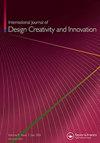Design spaces and EEG frequency band power in constrained and open design
IF 2.5
Q4 ENGINEERING, MANUFACTURING
International Journal of Design Creativity and Innovation
Pub Date : 2022-04-18
DOI:10.1080/21650349.2022.2048697
引用次数: 7
Abstract
ABSTRACT Design space is a common abstraction used in the investigation of design cognition. Characteristic properties of design spaces and how they change are underexplored. Design spaces can vary with the design task and its constraints, which are assumed to result in differences in neurocognitive processes. We review general cognition, creative cognition and design neurocognition EEG studies. We analyzed the brain activity of 32 professional mechanical engineers and industrial designers while performing constrained and open design tasks. The neurophysiological activations during reading the task, earliest reaction, and open externalization stages of constrained and open design are compared based on EEG frequency band power. Significant differences between constrained and open design for the beta bands were found in the earliest reaction stage. Significant differences between constrained and open design for alpha 2 and the beta bands were found in the open externalization stage. We discuss the results and relate the higher brain activity and significant differences in open design to cognitive functions of interest to design cognition. We show that EEG brain activation is sensitive to the level of constraints in designing, in particular alpha 2 and beta bands can act as proxies of the change and expansion of design spaces.受限开放设计中的设计空间与脑电频带功率
摘要设计空间是研究设计认知的常用抽象概念。设计空间的特征属性及其变化方式尚未得到充分的探索。设计空间可以随着设计任务及其限制而变化,这被认为会导致神经认知过程的差异。我们回顾了一般认知、创造性认知和设计神经认知脑电图的研究。我们分析了32名专业机械工程师和工业设计师在执行约束和开放设计任务时的大脑活动。基于EEG频带功率,比较了受限设计和开放设计在阅读任务、最早反应和开放外化阶段的神经生理学激活。在最早的反应阶段发现了β带的约束设计和开放设计之间的显著差异。在开放外化阶段,发现α2和β带的约束设计和开放设计之间存在显著差异。我们讨论了这些结果,并将开放设计中较高的大脑活动和显著差异与设计认知感兴趣的认知功能联系起来。我们表明,EEG大脑激活对设计中的约束水平很敏感,特别是α2和β带可以作为设计空间变化和扩展的代理。
本文章由计算机程序翻译,如有差异,请以英文原文为准。
求助全文
约1分钟内获得全文
求助全文
来源期刊

International Journal of Design Creativity and Innovation
ENGINEERING, MANUFACTURING-
CiteScore
3.80
自引率
27.80%
发文量
15
期刊介绍:
The International Journal of Design Creativity and Innovation is an international publication that provides a forum for discussing the nature and potential of creativity and innovation in design from both theoretical and practical perspectives. Design creativity and innovation is truly an interdisciplinary academic research field that will interest and stimulate researchers of engineering design, industrial design, architecture, art, and similar areas. The journal aims to not only promote existing research disciplines but also pioneer a new one that lies in the intermediate area between the domains of systems engineering, information technology, computer science, social science, artificial intelligence, cognitive science, psychology, philosophy, linguistics, and related fields. The journal covers, but is not restricted to, the following topics: ·Theories on Design Creativity and Innovation ·Cognition of Design Creativity ·Innovative Process ·Inventive Process ·Analogical Reasoning for Design Creativity and Innovation ·Design Synthesis ·Method and Tools for Design Creativity and Innovation ·Representation of Design Creativity and Innovation ·Education for Design Creativity and Innovation ·Concept Generation and Inspiration.
 求助内容:
求助内容: 应助结果提醒方式:
应助结果提醒方式:


